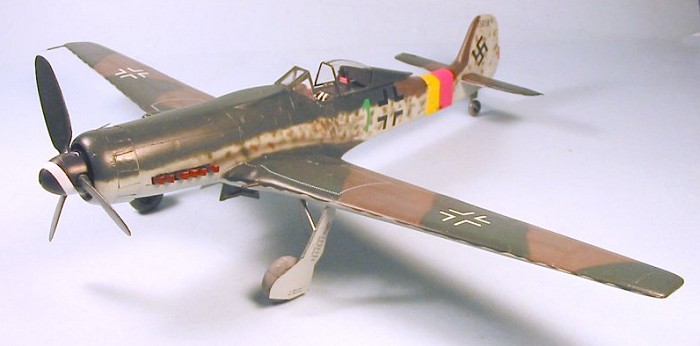
| KIT: | Rutman Resin 1/32 Ta-152H-1 |
| KIT #: | ? |
| PRICE: | $95.00 MSRP |
| DECALS: | No options |
| REVIEWER: | Tom Cleaver |
| NOTES: | Resin kit with metal bits |

| HISTORY |
The Ta‑152H was developed from the Ra‑1/Ra‑6, a series of related designs submitted by Kurt Tank in response to a request from the RLM in late 1942 for a Hochleistungsjaeger, a high‑ performance high altitude fighter. When the Technischen Amt accepted the Focke‑Wulf proposals in mid‑1943, Tank was accorded the unusual honor of having the new type designated after him, rather than being given a new "Fw" designation. The series became the Ta‑152, and the Ta‑152H was the only one of these to see any operational service before war’s end.
The Ta‑152H, with a longer fuselage and greater wingspan than any other
Focke‑Wulf Fw‑190 development, first appeared in prototype form in late
1944, when the Ta‑152 V3, V4 and V5 were delivered to Langenhagen. Powered
by a Jumo 213E in‑line engine, and armed with a 30mm Mk108
Motorkannon and two 20mm MG151s in the wing roots, the
 airplane had a
pressurized cockpit that gave the equivalent cabin altitude of 16,500 ft.
at 35,000 ft.
airplane had a
pressurized cockpit that gave the equivalent cabin altitude of 16,500 ft.
at 35,000 ft.
The first Ta‑152H‑0s - which lacked the wing fuel tanks and MW50 and GM1 systems of the operational Ta‑152H‑1 -, were in service with Erprobungskommando Ta152 in November and December 1944, under the command of Hauptmann Bruno Stolle.
Most of the Ta‑152H‑1s delivered for operational service in February and March 1945 were equipped with the R11 Ruestsatze, which included all‑weather instrumentation. Approximately 150 Ta‑152H's were produced by the Focke‑Wulf factory at Cottbus before the factory was abandoned in the face of the Soviet advance in April 1945.
One pilot who flew the Ta‑152H recalled that, "The flying characteristics of the Ta‑152H put all previous German fighters in the shade. Although I never flew the Me‑262, I would venture to say that the Ta‑152 was by far the superior when it came to dogfighting with the Allied fighters then in service. In my opinion, there was no better fighter in operational service at the time."
Oberfeldwebel Willi Reischke of the Stabschwarm, JG301 ‑ the only unit to take the Ta‑152H into battle ‑ had the opportunity on April 14, 1945, to demonstrate the truth of what the Ta‑152H could do as a dogfighter. The four aircraft of the Stabschwarm were scrambled to intercept two enemy fighters that were strafing ground targets a few miles from the field at Neustadt‑Glewe. The Schwarmfuehrer's wingman unexplainably dove into the ground as the Germans dove to attack what turned out to be two Hawker Tempests. Reischke fastened on to one of them in a dogfight that never went above 500 feet AGL. "At this altitude," recalled Reischke,"neither pilot could afford to make a mistake, and it was now that I began to fully appreciate what this airplane could do."
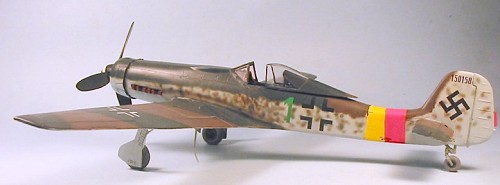 He pulled tighter and tighter turns, never approaching the limits of the
Ta‑152's capability. When the Tempest pilot ‑ unable to shake his pursuer
‑ tried to flick turn in the opposite direction, Reischke gave him a full
burst, and then his guns froze. He stayed in position where his opponent
would be able to see him, and literally flew New Zealand Warrant Officer
O.J. Mitchell into the ground by forcing him to turn so tight the Tempest
entered a high‑speed stall/spin.
He pulled tighter and tighter turns, never approaching the limits of the
Ta‑152's capability. When the Tempest pilot ‑ unable to shake his pursuer
‑ tried to flick turn in the opposite direction, Reischke gave him a full
burst, and then his guns froze. He stayed in position where his opponent
would be able to see him, and literally flew New Zealand Warrant Officer
O.J. Mitchell into the ground by forcing him to turn so tight the Tempest
entered a high‑speed stall/spin.
Reischke scored a total of 3 kills in the Ta‑152H in the closing weeks of April 1945. His comrade Feldwebel Joseph Keil, scored five kills during this time to become the only Ta‑152H ace.
Reischke's airplane, "Green 6," was surrendered to the RAF at the end of the war. It was disassembled and flown to Farnborough, where it was reassembled and flown twice by British test pilot Eric Brown, who was not a fan of the aesthetics of the Ta‑152 in comparison to the earlier Fw‑190 series airplanes he had flown, though he was highly impressed by its power, even without the MW50.
| THE KIT |
Jerry Rutman first brought out his 1/32 all-resin Ta-152H-1 a few years back. Having now sold out of that run of the kit, he has made some modifications to it to improve buildability, and now has this second edition available. It is the only 1/32 scale Ta-152H currently available. The kit includes photoetch cockpit detail parts, white metal landing gear, and two vacuform blown canopies. It does not include decals.
| CONSTRUCTION |
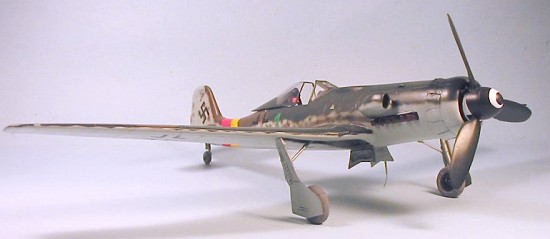 Construction begins with cleaning up the parts, which involves sanding the
joints all smooth and straight, cleaning off flash, and sanding the four
wing halves down so that they have sharp trailing edges and straight
leading edge joints. This takes perhaps an hour with the trusty Dremel
tool and a sheet of medium-rough wet-or-dry sandpaper. I also took this
opportunity to dremel out the interior of the fuselage around the exhaust
openings and the area where the engine would be mounted.
Construction begins with cleaning up the parts, which involves sanding the
joints all smooth and straight, cleaning off flash, and sanding the four
wing halves down so that they have sharp trailing edges and straight
leading edge joints. This takes perhaps an hour with the trusty Dremel
tool and a sheet of medium-rough wet-or-dry sandpaper. I also took this
opportunity to dremel out the interior of the fuselage around the exhaust
openings and the area where the engine would be mounted.
I then sanded down the gear well walls and attached them to the lower wing halves. Test-fitting the wing halves showed I needed to sand down the gear well walls a bit more. Once I had these fitting right, I glued the wing halves together and filled the leading edge seams with cyanoacrylate glue and set them aside.
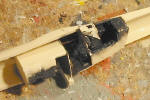 Turning to the fuselage, I checked the cockpit for fit inside the fuselage
halves, then painted the cockpit parts RLM66, using Xtracrylix paints.
When these were dry, I assembled the cockpit and attached it to the right
fuselage half.
Turning to the fuselage, I checked the cockpit for fit inside the fuselage
halves, then painted the cockpit parts RLM66, using Xtracrylix paints.
When these were dry, I assembled the cockpit and attached it to the right
fuselage half.
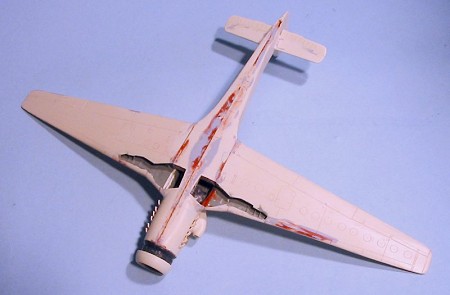 The engine plug was easily assembled and I painted it similarly to what I
had done with my Fw-190D-9 models. Once this was complete and installed in
position, I attached the exhaust stacks. Once I assembled the fuselage, I
also filled the centerline seams with cyanoacrylate glue.
The engine plug was easily assembled and I painted it similarly to what I
had done with my Fw-190D-9 models. Once this was complete and installed in
position, I attached the exhaust stacks. Once I assembled the fuselage, I
also filled the centerline seams with cyanoacrylate glue.
I made wing spars and attached them to the back of the wheel well bulkhead, then I attached the wings and filled those gaps with cyanoacrylate glue. I finished the basic assembly by attaching the horizontal stabilizers.
Once basic assembly was complete, I sanded down all the joints and seams, then applied Mr. Surfacer 500, and sanded them with finer-grit sandpaper. I then rescribed surface detail where necessary
The next step was to attach the radiator cowling and the photo-etch radiator flaps. This was very fiddly to say the least, and required at least two attempts per flap to get them in the correct position.
I then assembled the windscreen, using clear sheet plastic for the glass and attaching it to the resin frame, then attached it to the model, and attached the elevators to the horizontal stabilizers. We were ready to proceed with painting.
| COLORS & MARKINGS |
Painting.
 I
used Xtracrylix paints for all of this. First I pre-shaded the model with
flat black, then painted and masked the Reichverteidigung band for
JG301
I
used Xtracrylix paints for all of this. First I pre-shaded the model with
flat black, then painted and masked the Reichverteidigung band for
JG301
It’s generally believed that the Ta-152H was camouflaged in RLM 81/82 on the upper surfaces and RLM76 on the lower. When everything was dry, I gave the model an overall coat of Future.
Decals:
Decals came from the decal dungeon, using various markings from different sheets. The upper and lower wing insignia came from a 1/48 sheet for the Arado Ar-234, while the fuselage insignia, green 1 and the serial numbers came from a 1/32 Cutting Edge sheet for the Bf-109G-10. The swastika came from a 1/32 sheet for the Fw-190, as did all the stenciling. The airplane was done as “Green 1,” flown by the Stabschwarmfuhrer, Oberstleutnant Aufhammer. This was a case of force majeure, since I only had a green “1" in 1/32 in the decals. Jerry’s kit is based on the Ta-152 at the National Air and Space Museum, which was “Green 4,” and has a wooden tail assembly. I did not know what kind of tail “Green 1" had and I doubt anyone else does either. Another modeler who has built this kit used the resin metal Ta-152 tail from the Revell of Germany Fw-190D-9 limited-release kit.
| FINAL BITS |
I applied a coat of Xtracrylix Gloss Varnish, then attached the landing gear and prop. The Morane antenna and tailwheel came from spare parts out of a 1/32 Hasegawa Fw-190 kit. These airplanes were not subjected to heavy use before the end of the war and from photos they appear pretty clean, so all I did was apply some exhaust staining with Tamiya “Smoke.” The last thing to do was give the model a coat of Xtracrylix Flat Varnish.
| CONCLUSIONS |
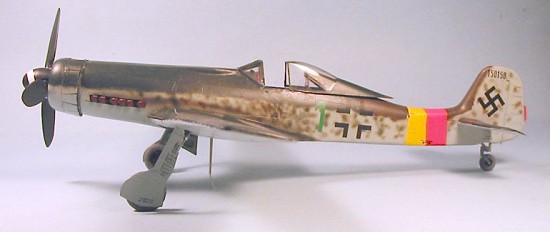 This kit is not so difficult that a modeler who has done at least one other
all-resin kit will have any great difficulty with this kit, which is a very
impressive model when completed.
This kit is not so difficult that a modeler who has done at least one other
all-resin kit will have any great difficulty with this kit, which is a very
impressive model when completed.
The Ta-152H is to my mind the strangest-looking Fw-190 - like an airplane on steroids that was stretched on the rack. It has its own aesthetic qualities, though. Once Jerry releases his coming Ta-152C-0, and Hasegawa releases their Fw-190A-3, I will have all the fighter versions of my favorite German fighter of the Second World War, in 1/32.
August 2005
Thanks to Jerry Rutman for the review kit.
If you would like your product reviewed fairly and quickly by a site that has around 300,000 visitors a month, please contact me or see other details in the Note to Contributors.